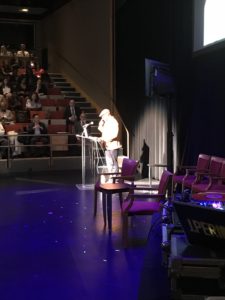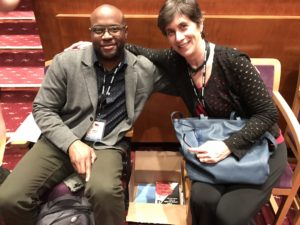Last month, I had the honor and privilege of participating in the Kennedy Center Arts Summit. The goal of the day was to “activate citizen artists, explore John F. Kennedy’s ideas and to shape our collective future.” The central focus was to envision the “future state of America, specifically focusing on how the arts can be utilized to address inequities and eradicate barriers within the landscapes of education, health and resources.” A small task! Participants included a mix of citizen artists (individuals selected by the Kennedy Center to receive support for their innovative ideas), teachers (arts and academic), policy makers, funders, and others from the field of education, finite resources, and health. The mixture of attendees was one of the strengths of the day, as was the way in which artists’ performances and panel discussions were interwoven to continue to inspire, explore, and propose action steps for the future states of America. All of this took place in the magnificent Kennedy Center in Washington, D.C. where the words of Kennedy framed our work:
The problems of the world cannot possibly be solved by skeptics or cynics whose horizons are limited by obvious realities. We need [people] who can dream of things that never were and ask, ‘why not?
The perfect embodiment of that quote was the opening performance by Ekene Ijeoma, an interdisciplinary artist that uses data and life experiences to confront social issues. The piece was “Deconstructed Anthems” and the musicians played through the national anthem. We, the audience, stood and listened. The musicians played again, but some of the notes were missing. This kept happening with more and more notes missing. The last iteration was done in silence. Only when the musicians looked up and lowered their instruments did we realize we could clap. But what had we just clapped for? What had been deconstructed? Ekene then came to the stage and explained that his piece was about mass incarceration and that the removal of notes was done at the same rate at which people are imprisoned in the United States. And we had stood for this?
So began our day together—a day that continued to juxtapose some of the most intractable issues of our time with artists and art that helped us explore these issues.
Next, Marc Bamuthi Joseph took the stage. He merges poetry, dance, and hip hop. He is a playwright and has just written the libretto for a new piece Bill T. Jones is choreographing called “Opera Philadelphia. He boldly told the audience that “Racism is so American that when we protest RACISM, the average American thinks we’re protesting AMERICA.” And yet Marc’s work and message is anything but hopeless. He quoted from Shakespeare’s A Midsummer Night’s Dream:
“…as imagination bodies forth,
The forms of things unknown, the poet’s pen
Turns them into shapes and gives to airy nothing
A local habitation and a name.”
This quote evokes a better world and Marc used these words to urge us to think about the power of our collective imaginations “to choreograph social justice.” Marc’s life work has been dedicated to using the arts to shine a light on the ways we can improve society.
I was so proud to be in the company of this artist. Our charge was to engage in a “long conversation” and discuss these questions:
- When you envision our future state, thinking about the arts alongside education, health, and/or environmental sustainability, what is the smallest thing we can do that might bring about transformational change and profound impact?
- Where do we see the greatest opportunities for transformational change, and finally, what would make our dreams come true?
Marc had set the stage by laying out the urgency of addressing racism and social justice. I spoke about the ways in which I have seen young people be able to confront racism and other destructive “isms” through their work in the arts—theatre, dance, music and visual arts, as well as creative writing. But I also worried aloud about how in this era of high stakes testing, curriculum has become so narrow that the only thing that counts is the score on a test. Now we have two decades of young people who have only experienced double English and double math classes, (in order to raise test scores) and have had virtually no exposure to immersive art making. How will we choreograph for social justice if our young people have no creative tools to do so?
After our ten minutes of conversation was finished, Marc left the stage and Hank Willis Thomas joined me. He is a conceptual artist and his work incorporates themes of identity, commodity, media, and popular culture. Again, I felt so proud to be on stage with such a preeminent artist—and the son of another fantastic artist—Deborah Willis—who had worked with my Boston Arts Academy students some fifteen years ago. Hank and I discussed the same questions, more or less, that Marc and I had tackled. Then it was my turn to exit and another luminary took the stage, and so it went until the “long conversation” had cycled through a dozen people. It was a creative way to have many people from various backgrounds and experiences engage with the same questions.
After lunch, I moderated two different panels on education. Our focus questions were: How might we use the arts to foster empathy and connection among students and families from disparate communities? And, how we might use the arts and design to support the holistic needs of students, teachers and families?
Again, the participants came from a broad range of backgrounds. Participants ranged from playwright Idris Goodwin, to former Philadelphia public school principal, Linda Cliatt Wayman, to Jamie Broadnax, founder of Black Girl Nerds. The discussion amongst the dozen panelists was far reaching, provocative, and moving. There was deep agreement that the power of connection and storytelling for young people is an essential element for healthy communities. We spoke about the ways in which our current educational system, rather than deeply listening and embracing young people’s lived experiences, alienates and rejects the assets that young people bring with them to classrooms every day. And panelists discussed how artists both reflect and challenge the current state of society and how important it is that those artists can work alongside young people. There is power in problem solving through and with the arts. The panelists closed by reflecting on one actionable piece of advice for audience members involved in education. The list included: ensure that young people can be curious every day; make sure kids can move and be physical; use podcasts to teach; remember the power of playful and joyful experiences; bring in more and varied arts experiences for students; introduce monthly town meetings in schools and really listen to what students are saying; ask and answer for ourselves: what are the most important skills and dispositions we want our graduates to embody?
With that long list, we finally moved into action work in small groups. The prompt was: Reflecting on what we’ve heard all day, and what we have been bothered or inspired by, how might we make change? What would our future headline be that is solution-oriented? We worked intensely to develop some clear solutions given everything we had heard and experienced all day. Our group’s headline was the announcement of a new cabinet level Department of Imagination that takes inspiration from young artists and focuses on ways that love and joy can permeate all classrooms. While our idea may not ever be implemented, the conversation to get to this headline created a great deal of synergy and excitement so that we could return to our workplaces re-energized and able to re-commit to the young people we all work with.
Our day long gathering closed with students from the DC area and Boston’s Conservatory Lab Charter School playing in an El Sistema-inspired orchestra. These young people have been given the opportunity to develop a passion and a skill that brings them joy and opportunities for deep collaboration across age, gender, race, language, and geography. As we all listened, I believe we all recognized that daily high-quality arts instruction is a matter of social justice and equity.



